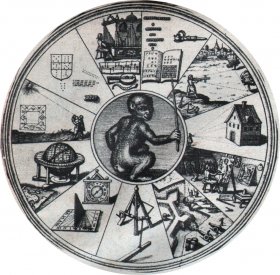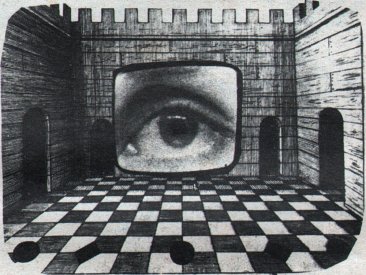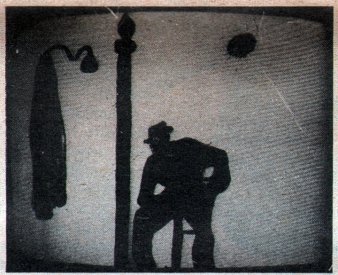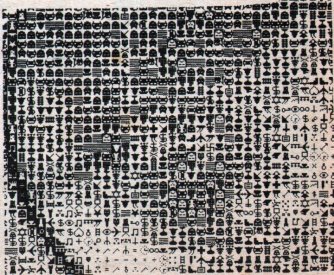The following material is from the Bush Video special issue of Tharunka XL-5, August 7, 1973, p.3. It has been edited only to the extent that I have fixed some typographical errors.
INSIDE A MEMORY THEATRE
Joseph El Khouri
In Campanella's “City of the Sun,” a Utopia of astral magic is described in which the round central Sun temple, painted with the images of the stars, was surrounded by the concentric circles of the walls of the city on which the whole world of the creation and of man and his activities was represented in images dependent on the central causal images. The “City of the Sun” could be used as an occult memory system through which everything could be quickly learned, using the world ‘as a book’ and as ‘local memory.’ The children of the Sun City were instructed by the Solarian priests who took them round the City to look at the pictures, whereby they learned the alphabets of all languages and everything else through the images on the walls. The pedagogic method of the highly occult Solarians, and the whole plan of their City and its images, was a form of local memory, with its places and images.
General principles of the Classical art of memory.
The first step was the imprint on the memory of a series of Loci or places, the commonest though not the only type of mnemonic place system used was the Architectural type. In order to form a series of places in memory a building is to be remembered, the forecourt, the living room, bedrooms, parlours, not admitting statues and other ornaments which have been memorized in the building. This is done as soon as the memory of the facts is required, all these places are visited and their various deposits are retrieved.
The art developed in classical antiquity as an assistant to the art of oration.
The memory theatre of the Divine Camillo.
“They say that this man has constructed an amphitheatre into which whoever is admitted as a spectator will be able to discourse on any subject ... I spoke to him about his work. He calls his theatre by many names, saying now that it is built or constructed mind and soul, and now that it is a windowed one. He pretends that all things that the human mind can conceive and which we cannot see with the corporeal eye, after being collected together by diligent meditation may be expressed by certain corporeal signs in such a way that the beholder may at once perceive with his eyes everything that is otherwise hidden in the depths of the human mind. And it is because of this corporeal looking that he calls it a theatre."
Camillo's theatre rests basically upon seven pillars, the Seven Pillars of Solomon's House of Wisdom.
By these columns’ signifying most stable eternity, we are to understand the seven sephiroth of the super-celestial world, which are the seven measures of the celestial and inferior worlds, in which are contained the ideas of all things both in the celestial and in the inferior worlds.
In his memory building the Universe will be remembered through organic association of all its parts with their underlying eternal order.
The basic images are those of planetary gods and under the images there were drawers of writings related to the subjects recalled by the images.
Today it would look like a huge ornamental filing cabinet. But we should not lose sight of the grandeur of the idea - the Idea of a memory organically geared to the Universe.
Giordano Bruno’s Art of Memory.
"A most solid foundation for the truths and secrets of nature. For you must know that it is by one and the same ladder that nature descends to the production of things and the intellect ascends to the knowledge of them; and that the one and the other proceeds from unity and returns to unity, passing through the multitude of things in the middle." (Giordano Bruno)
The aim of the memory system is to establish within, in the psyche, the return of the intellect to unity through the organization of significant images.
The images of the stars are intermediaries between the ideas in the super-celestial world and the sub-celestial elemental world. By arranging or manipulating or using the star-images one is manipulating forms which are a stage nearer to reality than the objects in the inferior world, all of which depend on the stellar influences.
One can act on the inferior world, change the stellar influences on it, if one knows how to arrange and manipulate the star-images. In fact the star-images are the ‘shadows of ideas,’ shadows of reality which are nearer to reality than the physical shadows in the lower world.
Let us contemplate the spectacle of the statues of gods and goddesses, assimilated to the stars, revolving, both as magic images of reality and as memory images comprehending all possible notions, on the wheel in Bruno's “Statues.” Or think of the inextricable maze of memory rooms in “Images,” full of images of all things in the elemental world, controlled by the significant images of the Olympian gods.
It is not enough to say vaguely that the memory wheels worked by magic. It was a highly systematized magic. Thus the images of decans of the zodiac, the images of the planets, the images of the moon-stations would form and reform in ever changing combinations, in connection with the images of the houses. Did he intend that there would be formed in the memory using these ever-changing combinations of astral images some kind of alchemy of the imagination, a philosopher's stone in the psyche through which every possible arrangement and combination of objects in the lower world - plants, animals, stones - would be perceived and remembered? And that, in the forming and reforming of the inventor's images in accordance with the forming and reforming of the astral images on the central wheel, the whole history of man would be remembered from above, as it were, all his discoveries, thoughts, philosophies, productions?
Such a memory would be the memory of a divine man, of a Magus with divine powers through his imagination harnessed to the. workings of the cosmic powers. And such an attempt would rest on the Hermetic assumption that man's mens is divine, related in its origin to the star-governors of the world, able both to reflect and to control the universe.
Magic assumes laws and forces running through the universe which the operator can use, once he knows the way to capture them. The Renaissance conception of an animistic universe, operated by magic, prepared the way for the conception of a mechanical universe, operated by mathematics. In this sense, Bruno's vision of an animistic universe of innumerable worlds through which run the same magico-mechanical laws, is a prefiguration, in magical terms, of the seventeenth-century vision. But Bruno's main interest was not in the outer world but in the inner world. And in his memory systems we see the effort to operate the magico-mechanical laws, not externally, but within, by reproducing in the psyche the magical mechanisms. The translation of this magical conception into mathematical terms has only been achieved in our own day. Bruno's assumption that the astral forces which govern the outer world also operate within, and can be reproduced or captured there to operate a magical-mechanical memory, seems to bring one curiously close to the mind machine which is able to do so much of the work of the human brain by mechanical means.
The Art of Memory in the 14th century is followed by Robert Fludd, who is in the Renaissance tradition, and also by thinkers who are taking it in new directions, Bacon, Descartes, Leibniz. In the 17th century the art of memory underwent yet another of its transformations turning from a method of memorising the Encyclopedia of Knowledge, and reflecting the world in memory to an aid for investigating the Encyclopedia and the world with the object of discovering new Knowledge
“The Monads of Leibniz.”
Mnemonica, says Leibniz, provides the matter of an argument; Methodologia gives it form; and Logica is the application of the matter to the form. He then defines Mnemonica as the joining of the image of some sensible thing to the thing to be remembered, and this image he calls a nota. He then mentions that things seen are better remembered than things heard.
In this new mathematical-Lullist art, says Leibniz, notae will be used as an alphabet. These notae are to be as ‘natural’ as possible, a universal writing. They may be like geometrical figures, or like the ‘pictures’ used by the Egyptians and the Chinese, though Leibnizian notae will be better for ‘memory’ than these.
As is well known, Leibniz formed a project known as the characteristica. Lists were to be drawn up of all the essential notions of thought, and to these notions were to be assigned symbols or ‘characters.’ The ‘characters’ were to be used in logical combinations to form a universal art or calculus for the solution of all problems.
Allied to the characteristica or calculus in Leibniz's mind was the project for an encyclopedia which was to bring together all the arts and sciences known to man. When all knowledge was systematised in the encyclopedia, ‘characters’ could be assigned to all notions, and the universal calculus would eventually be established for the solution of all problems. Leibniz envisaged the application of the calculus to all departments of thought and activity. Even religious difficulties would be removed by it.
It was through his invention of new ‘characters’ that he was able to operate the infinitesimal calculus, which was but a fragment, or a specimen, of the never completed ‘universal characteristic.’
The word Monad was borrowed by Leibniz from Bruno. Though Leibniz as a philosopher of the 17th century has moved into another atmosphere and a new world he bears obvious marks from the Hermetic tradition. The Leibnizian monads when they are human souls having memory, have as their chief function the representation or reflection of the universe of which they are living mirrors.
If I were to choose a patron saint for cybernetics out of the history of science, I should have to choose Leibniz. The Philosophy of Leibniz centres about two closely related concepts - that of a universal symbolism and that of a calculus of reasoning. From these are descended the mathematical notation and the symbolic logic of the present day. [Norbert Weiner - "Cybernetics']
History of The Art of Memory adapted from Francis Yates’ “The Art of Memory.”











